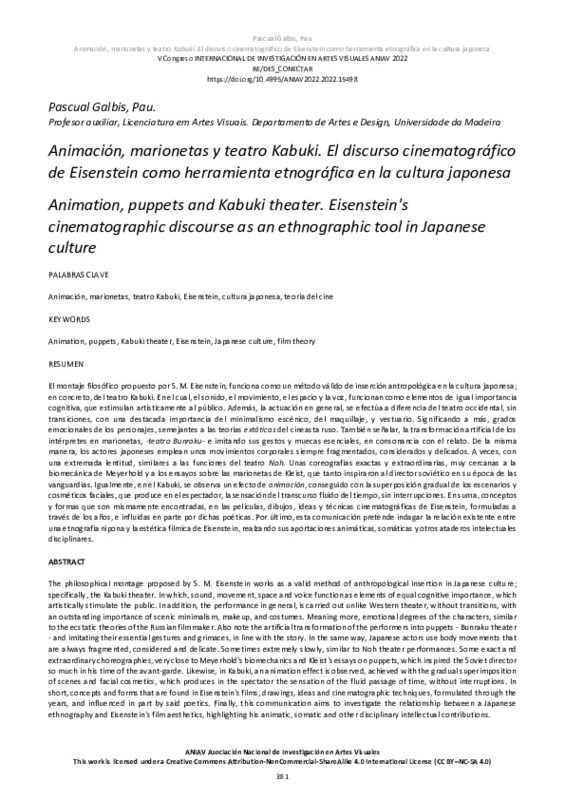JavaScript is disabled for your browser. Some features of this site may not work without it.
Buscar en RiuNet
Listar
Mi cuenta
Estadísticas
Ayuda RiuNet
Admin. UPV
Animación, marionetas y teatro Kabuki. El discurso cinematográfico de Eisenstein como herramienta etnográfica en la cultura japonesa
Mostrar el registro sencillo del ítem
Ficheros en el ítem
| dc.contributor.author | Pascual Galbis, Pau
|
es_ES |
| dc.date.accessioned | 2022-09-19T12:02:21Z | |
| dc.date.available | 2022-09-19T12:02:21Z | |
| dc.date.issued | 2022-07-15 | |
| dc.identifier.isbn | 9788413960272 | |
| dc.identifier.uri | http://hdl.handle.net/10251/186298 | |
| dc.description.abstract | [EN] The philosophical montage proposed by S. M. Eisenstein works as a valid method of anthropological insertion in Japanese culture; specifically, the Kabuki theater. In which, sound, movement, space and voice function as elements of equal cognitive importance, which artistically stimulate the public. In addition, the performance in general, is carried out unlike Western theater, without transitions, with an outstanding importance of scenic minimalism, makeup, and costumes. Meaning more, emotional degrees of the characters, similar to the ecstatic theories of the Russian filmmaker. Also note the artificial transformation of the performers into puppets - Bunraku theater - and imitating their essential gestures and grimaces, in line with the story. In the same way, Japanese actors use body movements that are always fragmented, considered and delicate. Sometimes extremely slowly, similar to Noh theater performances. Some exact and extraordinary choreographies, very close to Meyerhold's biomechanics and Kleist's essays on puppets, which inspired the Soviet director so much in his time of the avant-garde. Likewise, in Kabuki, an animation effect is observed, achieved with the gradual superimposition of scenes and facial cosmetics, which produces in the spectator the sensation of the fluid passage of time, without interruptions. In short, concepts and forms that are found in Eisenstein's films, drawings, ideas and cinematographic techniques, formulated through the years, and influenced in part by said poetics. Finally, this communication aims to investigate the relationship between a Japanese ethnography and Eisenstein's film aesthetics, highlighting his animatic, somatic and other disciplinary intellectual contributions. | es_ES |
| dc.description.abstract | [ES] El montaje filosófico propuesto por S. M. Eisenstein, funciona como un método válido de inserción antropológica en la cultura japonesa; en concreto, del teatro Kabuki. En el cual, el sonido, el movimiento, el espacio y la voz, funcionan como elementos de igual importancia cognitiva, que estimulan artísticamente al público. Además, la actuación en general, se efectúa a diferencia del teatro occidental, sin transiciones, con una destacada importancia del minimalismo escénico, del maquillaje, y vestuario. Significando a más, grados emocionales de los personajes, semejantes a las teorías extáticas del cineasta ruso. También señalar, la transformación artificial de los intérpretes en marionetas, -teatro Bunraku - e imitando sus gestos y muecas esenciales, en consonancia con el relato. De la misma manera, los actores japoneses emplean unos movimientos corporales siempre fragmentados, considerados y delicados. A veces, con una extremada lentitud, similares a las funciones del teatro Noh. Unas coreografías exactas y extraordinarias, muy cercanas a la biomecánica de Meyerhold y a los ensayos sobre las marionetas de Kleist, que tanto inspiraron al director soviético en su época de las vanguardias. Igualmente, en el Kabuki, se observa un efecto de animación, conseguido con la superposición gradual de los escenarios y cosméticos faciales, que produce en el espectador, la sensación del transcurso fluido del tiempo, sin interrupciones. En suma, conceptos y formas que son mismamente encontradas, en las películas, dibujos, ideas y técnicas cinematográficas de Eisenstein, formuladas a través de los años, e influidas en parte por dichas poéticas. Por último, esta comunicación pretende indagar la relación existente entre una etnografía nipona y la estética fílmica de Eisenstein, realzando sus aportaciones animáticas, somáticas y otros ataderos intelectuales disciplinares. | es_ES |
| dc.format.extent | 10 | es_ES |
| dc.language | Español | es_ES |
| dc.publisher | Editorial Universitat Politècnica de València | es_ES |
| dc.rights | Reconocimiento - No comercial - Compartir igual (by-nc-sa) | es_ES |
| dc.subject | Animación | es_ES |
| dc.subject | Marionetas | es_ES |
| dc.subject | Teatro Kabuki | es_ES |
| dc.subject | Eisenstein | es_ES |
| dc.subject | Cultura japonesa | es_ES |
| dc.subject | Teoría del cine | es_ES |
| dc.subject | Animation | es_ES |
| dc.subject | Puppets | es_ES |
| dc.subject | Kabuki theater | es_ES |
| dc.subject | Japanese culture | es_ES |
| dc.subject | Film theory | es_ES |
| dc.title | Animación, marionetas y teatro Kabuki. El discurso cinematográfico de Eisenstein como herramienta etnográfica en la cultura japonesa | es_ES |
| dc.title.alternative | Animation, puppets and Kabuki theater. Eisenstein's cinematographic discourse as an ethnographic tool in Japanese culture | es_ES |
| dc.type | Capítulo de libro | es_ES |
| dc.type | Comunicación en congreso | es_ES |
| dc.identifier.doi | 10.4995/ANIAV2022.2022.15498 | |
| dc.rights.accessRights | Abierto | es_ES |
| dc.description.bibliographicCitation | Pascual Galbis, P. (2022). Animación, marionetas y teatro Kabuki. El discurso cinematográfico de Eisenstein como herramienta etnográfica en la cultura japonesa. Editorial Universitat Politècnica de València. 381-390. https://doi.org/10.4995/ANIAV2022.2022.15498 | es_ES |
| dc.description.accrualMethod | OCS | es_ES |
| dc.relation.conferencename | V Congreso Internacional de Investigacion en Artes Visuales ANIAV 2022. RE/DES Conectar | es_ES |
| dc.relation.conferencedate | Julio 06-08, 2022 | es_ES |
| dc.relation.conferenceplace | Valencia, España | es_ES |
| dc.relation.publisherversion | http://ocs.editorial.upv.es/index.php/ANIAV/ANIAV2022/paper/view/15498 | es_ES |
| dc.description.upvformatpinicio | 381 | es_ES |
| dc.description.upvformatpfin | 390 | es_ES |
| dc.type.version | info:eu-repo/semantics/publishedVersion | es_ES |
| dc.relation.pasarela | OCS\15498 | es_ES |








